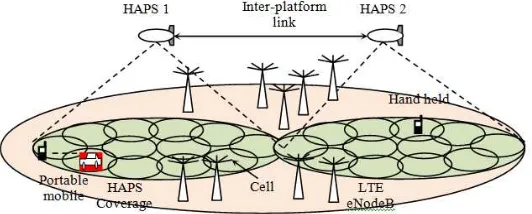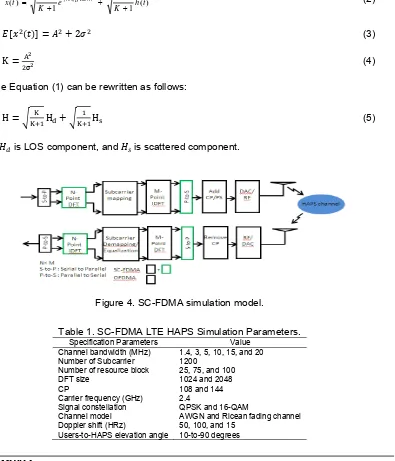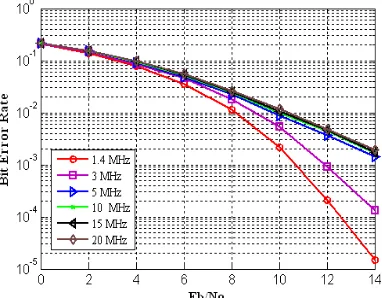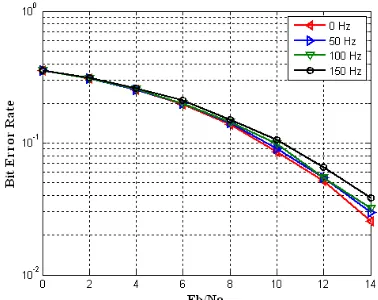DOI: 10.12928/TELKOMNIKA.v14i1.2646 515
SC-FDMA LTE Performance through High Altitude
Platforms Communications (HAPS) Channel
Iskandar*, D. Hidayat
School of Electrical Engineering and Informatics, Bandung Institute of Technology, Jalan Ganesha No. 10, Bandung 40132, INDONESIA
*Correspponding author, e-mail: [email protected]
Abstract
It is known that high altitude platform system (HAPS) is one of the promising wireless technologies that exploit many advantages from cellular satellite system as well as from cellular terrestrial system. HAPS is envisaged to be a novel technology for communication, broadcasting, internet backbone, earth observation and surveillance, and also for navigation. One of upcoming technologies for communication is a long term term evolution (LTE) of a cellular forth generation (4G). Many techniques have been developed to make LTE come into real in the environment of cellular terrestrial. However, LTE that deployed through HAPS is a challenging due to different its geometry and channel. This paper aims at evaluating the performance of a pilot-based channel estimation for uplink LTE using SC-FDMA over Ricean HAPS communication channel. Pilot-based channel estimation is used to estimate an uplink channel of LTE users who transmit the data to HAPS as a base transceiver station (BTS). Analysis is performed to determine the effect of user’s elevation angle with respect to user position inside HAPS coverage, LTE channel bandwidth, modulation type, and the Doppler frequency shift effect. We found that user’s elevation angle contribute major effect to the pilot-based channel estimation of LTE SC-FDMA performance. System capability to overcome fading effect that users with low elevation angle would be needed to increase the performance. In particular to keep an acceptable performance, in this paper we compensate the channel bandwidth, changing modulation type, and limit the Doppler Effect through vehicle speed limitation.
Keywords: Long Term Evolution, SC-FDMA, High Altitude Platforms, pilot-based channel estimation, Ricean fading channel.
Copyright © 2016 Universitas Ahmad Dahlan. All rights reserved.
1. Introduction
Long Term Evolution (LTE) is the latest generation of mobile cellular communications technology which is developed by 3rd Generation Partnership Project (3GPP) [1-3]. LTE is designed to be an efficient cellular technology on the use of frequency spectrum, high transmission data rate (more than 50 Mbps on the uplink and 100 Mbps on the downlink), simple architecturally, support high mobility communications, low delay, and high throughput. LTE uses Single Carrier Frequency Division Multiple Access (SC-FDMA) for uplink and Orthogonal Frequency Division Multiple Access (OFDMA) for the downlink. LTE technology has many options to use spectrum bandwidth, starting from 1.4 MHz, 3 MHz, 5 MHz, 10 MHz, 15 MHz and 20 MHz. This bandwidth flexibility brings LTE to be the best technology ever of cellular communication and potential to offer high-speed data rate [4-5].
Figure 1. Network architecture of cellular LTE via HAPS.
There is very few contributions deal with LTE that deployed via HAPS which has a unique geometry channel compared with cellular terrestrial channel. Uplink and downlink of LTE performance is discussed in [6]. Downlink performance of multiple access using OFDMA has been discussed in [7]. However, those papers deal with cellular communication for terrestrial system which is based on terrestrial tower. The channel characteristic must be different from that of HAPS channel characteristic. In this paper, SC-FDMA’s performance on HAPS with pilot-based channel estimation will be analyzed [8-10]. In our previous work, we have studied the downlink LTE characteristic over HAPS channel using channel estimation algorithm [11]. However, for the uplink, LTE uses another multiple access scheme namely SC-FDMA to save the power transmit so that it can save the battery life of the UE terminal. SC-FDMA’s performance on a HAPS channel is evaluated based on a computer simulation. The result will be analyzed to determine the effect of elevation angle, channel bandwidth, modulation type and Doppler frequency on system’s performance. Characteristic of channel is taken from research of HAPS in Hokkaido, Japan [12]. HAPS is using Ricean channel that modeled the condition of Line of Sight (LOS) and multipath due to user’s location and landmark circumstances. K factor is used as a parameter to indicate LOS ratio.
The possible configuration between cellular network provided by HAPS and terrestrial tower will be very interesting. However, we have to be carefully designed the network from interference. The cell coverage of HAPS must be separated away with enough distance from cell coverage of terrestrial BTS to avoid co-channel interference. An area called blank spot of terrestrial tower will be covered by HAPS. We found that the performance evaluation of LTE downlink over the HAPS channel has not been much investigated.
The rest of paper is organized as follows. Section 2 reviews SC-FDMA on LTE while in section 3 we review High Altitude Platforms channel model and characteristic. In Section 4, we explain simulation model for signal transmission of LTE uplink over HAPS channel. Then simulation results are analyzed in Section 5. We focus our analysis on the effect of user’s elevation angle, LTE spectrum bandwidth, modulation type, and Doppler frequency shift. Finally, conclusions are drawn in Section VI.
2. Pilot-based SC-FDMA in LTE-HAPS Channel
Figure 2. SC-FDMA resource grid [8].
Resource block structure on SC-FDMA can be described as in Figure 2. A resource block has duration of 0.5 ms and bandwidth of 180 kHz (12 subcarriers). All the resource blocks constitute of a resource grid. The number of blocks in the resource grid ranges from 6 to 100 for 1.4 MHz channels to 20 MHz channels, respectively. Each uplink slot carries seven SC-FDMA symbols. The smallest element in a resource block is called Resource Element which contains a subcarrier for the duration of one SC-FDMA symbol [13-14].
Pilot signal is used as reference signal that is required to perform channel estimation at the receiver output [15]. Pilot signal is inserted at specific symbol and when it pass through the channel, it will be processed with a method that estimates channel condition and then compensate it to another symbols. Pilot signal is generated based on Zadoff-Chu sequence. Zadoff-Chu sequence commonly referred as Constant Amplitude Zero Auto Correlation (CAZAC) sequence with the following equation.
, 0 (1)
Where q is Zadoff-Chu sequence root index, Nzc is sequence length and m = 0,1,….Nzc – 1. Zadoff-Chu has constant amplitude, so does it’s Nzc-point DFT and PAPR.
High Altitude Platforms located in the stratosphere, at an altitude between 17 and 22 km above the earth surfaces. HAPS have a rapid roll-out capability and the ability to serve a large number of users, using considerably less communications infrastructure than required by a terrestrial network. HAPS located in the stratosphere which has constant temperature rise and constant wind speed rise. There is no weather phenomenon occurs in this layer because this layer has low content of water. That is also this layer is stable with only slight turbulence. No clouds on this layer thus allow effective use of solar power.
SPF channel can be characterized using Rician distribution as follows. Where K is Rice factor, (t) is the users elevation angle, fD is Doppler shift from receiver movement, and h(i) is the scattered component. If the total power of scattered signal is denoted by 2 and power of LOS signal represented as , then the total received power and K factor are given by:
) ( )
( ( cos()
t h K e
K K t
x j fD t
1 1 1
2
(2)
2 (3)
K σ (4)
Then the Equation (1) can be rewritten as follows:
H H H (5)
Where is LOS component, and is scattered component.
Figure 4. SC-FDMA simulation model.
Table 1. SC-FDMA LTE HAPS Simulation Parameters.
Specification Parameters Value Channel bandwidth (MHz) 1.4, 3, 5, 10, 15, and 20 Number of Subcarrier 1200
Number of resource block 25, 75, and 100
DFT size 1024 and 2048
CP 108 and 144
Carrier frequency (GHz) 2.4
Signal constellation QPSK and 16-QAM
Channel model AWGN and Ricean fading channel Doppler shift (HRz) 50, 100, and 15
3. SC-FDMA in HAPS Channel Simulation Model
The processing of SC-FDMA signal is transmitted very similar to that of OFDMA. The sequence of bits transmitted for each user, is mapped into a complex constellation of symbols such as BPSK, QPSK or M-QAM. Then different transmitters (users) are assigned different Fourier coefficients. This assignment is carried out in the mapping and de-mapping blocks. Pilot-based channel estimation, which is used to estimate the performance of signal transmission of SC-FDMA LTE on HAPS channel, was evaluated through computer simulations. The structure of simulation model is depicted in Figure 4. At the transmitter, the series of bit is generated and converted from serial to parallel, then modulated into symbol. Pilot signal is then inserted at each first symbol in all subcarrier. These modulated symbols and pilots perform M-point Discrete Fourier Transform (DFT) to produce a frequency domain representation of the symbols. It then maps each of the M-point DFT outputs to one of the orthogonal subcarriers mapping that can be transmitted.
The receiver side includes one de-mapping block, one IDFT block, and one detection block for each user signal to be received. Just like in OFDM, guard intervals (called cyclic prefixes) with cyclic repetition are introduced between blocks of symbols in view to efficiently eliminate inter-symbol interference from time spreading (caused by multi-path propagation) among the blocks. In SC-FDMA, multiple access among users is made possible by assigning different users different sets of non-overlapping Fourier-coefficients (sub-carriers). This is achieved at the transmitter by inserting (prior to IFFT) silent fourier-coefficients (at positions assigned to other users), and removing them on the receiver side after the FFT.
In this paper, distributed method is used for subcarrier mapping. In this method, the outputs are allocate/d equally spaced subcarrier with zeros occupying the unused subcarrier in between. Then IDFT block followed by Cyclic Prefix (CP) insertion. Cyclic prefix is a copy of the last part of symbol that placed in front of symbol that can eliminate Inter Symbol Interference (ISI). Then the signal is transmitted through the HAPS Ricean channel. At the receiver, the opposite set of the operation is performed. CP is removed then the signal is processed by the DFT. Pilot signal then being extracted to get the channel condition. Channel condition then being compensated to the other symbols.
Table 2. Simulation parameters of channel bandwidth investigation
Specification Parameters Sample#1 Sample#2 Sample#3 Sample#4 Sample#5 Sample#6
Channel bandwidth (MHz) 1.4 3 5 10 15 20
Modulation QPSK QPSK QPSK QPSK QPSK QPSK
Number of resource block 6 15 25 50 75 100
elevation angle between the transmitter and HAPS is more than 400 and Eb/No is more than 6 dB. At that condition, we can obtain BER difference about 0.0182 to 0.090546 at same elevation angle.
4.2. Channel Bandwidth Analysis
Another result of our investigation on SC-FDMA scheme based on pilot-aided channel estimation on a HAPS channel is an effect of channel bandwidth. Our simulation is performed at 6 channel bandwidth, which are 1.4 MHz, 3 MHz, 5 MHz, 10 MHz, 15 MHz and 20 MHz. Simulation parameters are summarized in Table 2. Figure 6 shows that the greater the bandwidth of the channel, then the performance will be worse. BER decreases ranging from 1.4 MHz to 20 MHz. This is because the greater the channel bandwidth, the greater the noise power contribute to the channel. SC-FDMA is a multiple access scheme that has low peak to average power ratio (PAPR). Based on simulation results, performance will be decreased from half to 12 times when compared with 1.4 MHz bandwidth performance. Large channel bandwidth with poor performance can be solved with increasing the power transmit on the user equipment side. A compromise between elevation angle (coverage) and the channel bandwidth usage will lead us to an advantage wireless system brought by HAPS.
Figure 5. SC-FDMA scheme performance through HAPS channel as a function of
elevation angle
Figure 6. SC-FDMA scheme performance through HAPS channel as a function of
Channel bandwidth
4.3. Modulation Type Analysis
channel. The result is that there is a big difference between performance of SC-FDMA with QPSK modulation and with the 16-QAM modulation. This is because QPSK only use 2 bits per symbol while the 16-QAM uses 4 bits per symbol, so the 16-QAM will be more susceptible to noise during transmission. In the 16-QAM modulation, constellation of each point is closer to the other point than QPSK, so that the noise would be more likely to occur. Average distance of points on QPSK constellation is 2√2 while 16-QAM average distance is 2√10. If that distance is compared on dB, we will get 7 dB differences. This means that to get the same BER, 16-QAM requires approximately 7 dB from the QPSK need. From the simulation results, for QPSK with 900 elevation angle with Eb/N0 = 0 dB, we get 0.2067 of BER. So, 16-QAM will need Eb/N0 = 7 dB to get the same BER. However, because in the simulation, Eb/N0 is increasing by 2 dB, then the closest Eb/N0 is 8 dB which have 0.2277 BER Difference between the simulation results with the calculation because the simulations carried out with Eb/No increase per 2 dB, so the results are not very accurate.
Figure 7. SC-FDMA scheme performance through HAPS channel as a function of modulation type using 400 and 900 elevation
angle
Figure 8. SC-FDMA scheme performance through HAPS channel as a function of Doppler frequency using 700 elevation angle
4.4. Doppler Frequency Analysis
The last investigation in SC-FDMA performance via HAPS channel is an effect of Doppler shift to investigate the mobility characteristic of the user equipment. Simulation performed with parameter shown in Table 1, but with 4 different Doppler frequencies which is 0, 5, 10 and 150 Hz. Figure 8 shows the simulation result. It shows that the performance is better when the Doppler frequency is smaller. Doppler frequency of HAPS is less influential on greater elevation angle. This is due to the Doppler Effect is influenced by transmitter movement toward or away from HAPS. The greater the angle, the effect will be less significant, just like what we get from elevation angle analysis. In 2.4 GHz frequency, the speed of user equipment for the Doppler shift of 150 Hz will be around 200 km/h. We again will have a trade-off between HAPS coverage which is determined by an elevation angle and the mobility of user equipment. Without Doppler compensation technique, LTE with tens Mbps of data transmission rate in a HAPS system would have moderate performance. It is required compensation technique to improve the performance in a high bit rate transmission while user is moving with a very high speed. This is our challenge for future investigation of LTE deployed via HAPS.
5. Conclusion
Proceeding of Global Telecommunications Conference. San Fransisco. 2000; 1: 225-230.
[5] D Grace, M Mohor. Broadband Communications via High Altitude Platforms. John Wiley & Sons Ltd. 2011.
[6] Aws Yonis, MFL Abdullah. Uplink and Downlink of LTE Release 10 in Cellular Communications.
International Journal of Informatics and Communication Technology (IJ-ICT). 2012; 1(1): 43-53. [7] Nasaruddin N, Melinda M, Ellsa FS. A Model to Investigate Performance of Orthogonal Frequency
Code Division Multiplexing. TELKOMNIKA Indonesian Journal of Electrical Engineering. 2012; 10(3): 579-585.
[8] Hyung G Myung, David J Goodman. Single Carrier FDMA, A New Air Interface for Long Term Evolution. UK: John Wiley and Sons, Ltd. 2008.
[9] MM Rana. A Pilot Based RLS Channel Estimation for LTE SC-FDMA in High Doppler Spread.
IJCSIS. 2010; 8(6).
[10] MM Rana. Channel Estimation Algorithms, Complexities and LTE Implementation Challenges.
IJCSIS. 2010; 8(8).
[11] MRK Aziz, Iskandar. Channel estimation for LTE downlink in High Altitude Platforms (HAPs) systems. ICoICT 2013. 2013: 182-186.
[12] Iskandar, Shigeru Shimamoto. Channel characterization and performance evaluation of mobile communication employing stratospheric platforms. IEICE Transactions on Communications. 2006; 89(3): 937-944.
[13] Che-Kang Sun. Channel Estimation and Equalization of SC-FDMA for LTE Uplink System. National Central University, Taiwan. 2009.
[14] Bahattin Karakaya, Huseyin Arslan, Hakan Ali Cirpan. Channel Estimation for LTE Uplink in High Doppler Spread. In Proceedings of IEEE WCNC. Las Vegas. 2008; 1: 1126-1130.
[15] Byung Jang Jeong, Hyun Kyu Chung. Pilot Structures for the Uplink Single Carrier FDMA Transmission Systems. Vehicular Technology Conference (VTC Spring). Singapore. 2008: 1: 2552-2556.

![Figure 2. SC-FDMA resource grid [8].](https://thumb-ap.123doks.com/thumbv2/123dok/255914.504943/3.595.196.404.606.751/figure-sc-fdma-resource-grid.webp)



